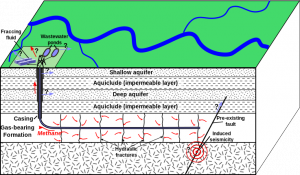California’s fracking opportunity
by Adam O'Neal | December 19, 2013 10:53 am
 [1]In 1973, President Richard Nixon launched Project Independence, an effort to make the United States energy independent by 1980. The actual project proved unsuccessful, but the concept stuck. Many politicians, especially presidential candidates, have since embraced the idea. After all, who wouldn’t want to be independent from oil-producing nations like Saudi Arabia?
[1]In 1973, President Richard Nixon launched Project Independence, an effort to make the United States energy independent by 1980. The actual project proved unsuccessful, but the concept stuck. Many politicians, especially presidential candidates, have since embraced the idea. After all, who wouldn’t want to be independent from oil-producing nations like Saudi Arabia?
Despite the persistent political predictions, energy independence hasn’t fully come to the United States. But advances in technology, particularly the newfound proliferation of the decades-old practice of hydraulic fracturing (or fracking), have made total energy independence a possibility. The International Energy Agency said in its 2013 World Energy Outlook[2] that the United States is moving “steadily towards meeting all of its energy needs from domestic resources by 2035.”
And advancements in fracking are the primary cause of this huge change. Millions of gallons of water, sand and chemicals are pumped underground in the fracking process. The high-pressure mixture travels through horizontally drilled wells and breaks apart rock to enable drillers access to shale oil and natural gas.
California State University, Bakersfield geology professor Janice Gillespie told CalWatchdog.com that the greatest danger with fracking comes from “poorly constructed and abandoned wellbores.”
“If the cement job is poorly done, the frack fluid could use the poorly constructed or abandoned wells as a conduit to the overlying fresh water aquifer,” she said.
California, a state perhaps best known for its luck with natural resources, has been lucky. The Monterey Shale, located in Central California, holds two-thirds of the United States’ accessible shale oil. In other words, California could be at the center of the United States’ most recent energy revolution — if the state embraces fracking.
Regulations
California, which is routinely identified as one of the most regulation-prone states in the country, issued a new set of regulations for oil drillers using the hydraulic fracking technique. They will take effect on Jan. 1, and a new set of similar regulations will be enacted a year later. Although the regulations are among some of the strictest in the country, drilling is expected to continue. And while environmental groups are unhappy that the state government hasn’t issued an outright ban, industry insiders publicly accept the rules.
So what are the drillers compelled to do? They have to alert nearby property-owners that they will be using fracking techniques a month before they begin fracking. And they are also required to conduct groundwater monitoring, test their wells, and make known which chemicals are being used in the mix.
Western States Petroleum Association president Catherine Reheis-Boyd told the New York Times[3] that the new set of rules “covers every possible area that one could think of.” She also said that the industry “accepts” the new regulations, according to the Times.
Gillespie said that regulations likely wouldn’t affect the amount of fracking in the state, explaining, “If the money is there they will frack.”
But she warned that it might be too soon to dismiss any impact that the regulations could have on the industry, because the current regulations were still being debated (and may be expanded).
“It may be a bit preliminary to jump to conclusions on this,” she warned.
- [Image]: http://calwatchdog.com/wp-content/uploads/2013/10/fracking-wikicommons.png
- 2013 World Energy Outlook: http://www.iea.org/media/executivesummaries/WEO_2013_ES_English_WEB.pdf
- told the New York Times: http://www.nytimes.com/2013/12/14/business/energy-environment/california-plans-tighter-control-of-fracking-but-not-enough-for-some.html?_r=0
Source URL: https://calwatchdog.com/2013/12/19/californias-fracking-opportunity/